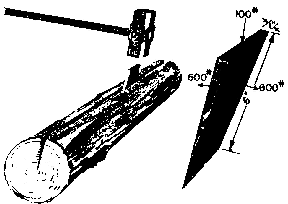CHAPTER 4
THE INCLINED PLANE AND THE WEDGE
CHAPTER LEARNING OBJECTIVES
Upon completion of this chapter, you should be able to do the following:
- Summarize the advantage of the barrel roll and the wedge.
You have probably watched a driver load barrels on a truck. He backs the truck up to the curb. The driver then places a long double plank or ramp from the sidewalk to the tailgate, and then rolls the barrel up the ramp. A 32-gallon barrel may weigh close to 300 pounds when full, and it would be a job to lift one up into the truck. Actually, the driver is using a simple machine called the inclined plane. You have seen the inclined plane used in many situations. Cattle ramps, a mountain highway and the gangplank are familiar examples.
The inclined plane permits you to overcome a large resistance, by applying a small force through a longer distance when raising the load. Look at figure 4-1. Here you see the driver easing the 300-pound barrel up to the bed of the truck, 3 feet above the sidewalk. He is using a plank 9 feet long. If he didn’t use the ramp at all, he’d have to apply 300-pound force straight up through the 3-foot distance. With the ramp, he can apply his effort over the entire 9 feet of the plank as he rolls the barrel to a height of 3 feet. It looks as if he could use a force only three-ninths of 300, or 100 pounds, to do the job. And that is actually the situation.
Here’s the formula. Remember it from chapter 1?
![]()
In which
L = length of the ramp, measured along the slope,
1 = height of the ramp,
R = weight of the object to be raised, or lowered,
E = force required to raise or lower the object.
Now apply the formula this problem:
In this case,
L = 9ft,
1 = 3 ft, and
R = 300 lb.
By substituting these values in the formula, you get
![]()
9E = 900
E = 100 pounds.
Since the ramp is three times as long as its height, the mechanical advantage is three. You find the theoretical mechanical advantage by dividing the total distance of the effort you exert by the vertical distance the load is raised or lowered.
THE WEDGE
The wedge is a special application of the inclined plane. You have probably used wedges. Abe Lincoln used a wedge to help him split logs into rails for fences. The blades of knives, axes, hatchets, and chisels act as wedges when they are forced into apiece of wood. The wedge is two inclined planes set base-to-base. By

Figure 4-1.—An inclined plane.

Figure 4-2.-A wedge.
driving the wedge full-length into the material to cut or split, you force the material apart a distance equal to the width of the broad end of the wedge. See figure 4-2.
Long, slim wedges give high mechanical advantage. For example, the wedge of figure 4-2 has a mechanical advantage of six. The greatest value of the wedge is that you can use it in situations in which other simple machines won’t work. Imagine the trouble you’d have trying to pull a log apart with a system of pulleys.
APPLICATIONS AFLOAT AND ASHORE
A common use of the inclined plane in the Navy is the gangplank. Going aboard the ship by gangplank illustrated in figure 4-3, is easier than climbing a sea ladder. You appreciate the mechanical advantage of the gangplank even more when you have to carry your seabag or a case of sodas aboard.
Remember that hatch dog in figure 1-10? The use of the dog to secure a door takes advantage of the lever principle. If you look sharply, you can see that the dog seats itself on a steel wedge welded to the door. As the dog slides upward along this wedge, it forces the door tightly shut. This is an inclined plane, with its length about eight times its thickness. That means you get a theoretical mechanical advantage of eight. In chapter 1, you figured that you got a mechanical advantage of four from the lever action of the dog. The overall mechanical advantage is 8 x 4, or 32, neglecting friction. Not bad for such a simple gadget, is it? Push down with 50 pounds heave on the handle and you squeeze the door

Figure 4-3.—The gangplank is an inclined plane.
shut with a force of 1,600 pounds on that dog. You’ll find the damage-control parties using wedges by the dozen to shore up bulkheads and decks. A few sledgehammer blows on a wedge will quickly and firmly tighten up the shoring.
Chipping scale or paint off steel is a tough job. How-ever, you can make the job easier with a compressed-air chisel. The wedge-shaped cutting edge of the chisel gets in under the scale or the paint and exerts a large amount of pressure to lift the scale or paint layer. The chisel bit is another application of the inclined plane.
SUMMARY
This chapter covered the following points about the inclined plane and the wedge:
The inclined plane is a simple machine that lets you raise or lower heavy objects by applying a small force over a long distance.
You find the theoretical mechanical advantage of the inclined plane by dividing the length of the ramp by the perpendicular height of the load that is raised or lowered. The actual mechanical advantage is equal to the weight of the resistance or load, divided by the force that must be used to move the load up the ramp.
The wedge is two inclined planes set base-to-base. It finds its greatest use in cutting or splitting materials.

Tidak ada komentar:
Posting Komentar